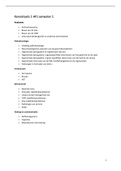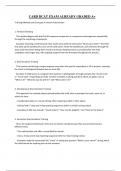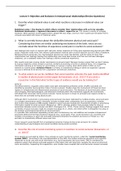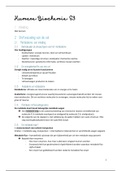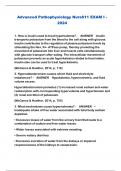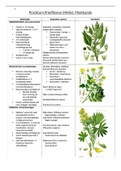Statistiek II - Psychologie
Inhoudsopgave
Hoofdstuk 0: Prolegomena 7
0.1 Situering van cursus(t.o.v. methodologie en psychometrie) 7
0.2. Variabelen 7
0.3 Meetniveau’s 8
0.4. Zinvolheid 9
0.5. Extra informatie 10
Hoofdstuk 1: data manipulatie 11
1.1 Data in R 11
1.1.1. R en meetniveau’s 12
1.1.2. Data frames 13
1.2. Excell 17
1.3 SPSS 17
1.4 Geimporteerde data en meetniveau’s 17
1.4.1 Numerieke variabelen 17
1.4.2 Niet numerieke variabelen 17
1.5 Het codeboek 17
1.5.1 Structuur 18
1.5.2 Codering 18
1.5.1 Missing data 18
Hoofdstuk 2 : Beschrijvende statistiek 19
2.1 Ordeningstechnieken 19
2.2 Grafische voorstellingen 20
2.3 Reductietechnieken 23
2.3.1 Centrummaten 23
2.3.2. Spreidingsmaten 25
2.3.3. Associatiematen 27
Extra: 30
Hoofdstuk 3: Kansrekenen 30
3.1 Toevalsproces en kansverdeling 30
3.1.0.1. De complementaire gebeurtenis 31
3.1.1 Toevalsvariabele 31
3.1.2. Kansen 32
3.1.2.1. Het begrip kans 32
2
, 3.1.2.2 Afhankelijkheid 32
3.1.3. Kansverdeling 33
3.1.4. Dichtheidsfunctie 34
3.1.5. Bivariate kansverdeling 35
3.1.6. Bivariate dichtheidsfunctie 36
3.1.7. Afhankelijke toevalsvariabelen 37
3.1.7.1. Discrete variabelen 37
3.1.7.2. Continue variabelen 38
3.1.8. Reductietechnieken 38
3.1.8.1. Discrete toevalsvariabelen 38
3.1.8.2. Continue toevalsvariabelen 39
3.1.9. Associatietechnieken 39
3.1.9.1. Discrete toevalsvariabelen 39
3.1.9.2. Continue toevalsvariabelen 40
3.1.10. Nuttige stellingen 40
3.2. Bijzondere kansverdelingen 41
3.3. Steekproevenverdeling 43
3.4. Steekproevenverdeling van X 43
3.5. Extra 44
Hoofdstuk 4: puntschatting 46
4.1. Eigenschappen van een goede schatter 46
4.3 Enkele schatters 47
4.3.1. Verwachting 47
4.3.2. Variantie 47
4.3.3.Covariantie 48
4.3.4. Correlatiecoëfficiënt 48
4.3.4. Extra informatie 49
5.1 Betrouwbaarheidsintervallen 49
5.1.1 De verdeling van X is normaal 49
5.1.2. De verdeling van X is niet normaal of onbekend 51
5.2. Andere betrouwbaarheidsintervallen 53
5.3. Extra info 53
Hoofdstuk 6: De statistische toetsen 53
6.1. Zijn de studenten FPPW slimmer? 53
6.1.0.1. Bijkomende hypothese 54
6.1.0.2. Zonder bijkomende hypothese 54
3
, 6.2. To be or not to be 55
6.3. De toetsingsprocedure 55
6.3.1. Theoretische hypothese 55
6.3.3. Nulhypothese 56
6.3.4. Eerste beslissing 56
6.3.5. Toetsingsgrootheid G 56
6.3.6. Overschrijdingskans of p-waarde 56
6.3.7. Beslissing 57
6.4. Toetsingsprocedure in actie 57
6.5. Keuze van toetsingsgrootheid 57
6.5.1. Het toetsen van hypothese betreffende µ 57
6.5.2. Het toetsen van hypothese betreffende twee verwachtingen 60
6.5.2.2. Afhankelijke steekproeven 61
6.6. Toetsen van hypothese betreffende een proportie(of kans) 61
6.7. Normaliteitsassumptie 62
6.7.1 De normale quantile quantile plot 62
6.7.2. Toepassing van de normale qq-plot 62
6.8. Significantie 62
6.9 Fouten 62
6.9.1 Twee soorten fouten 62
6.10 Extra 63
Hoofdstuk 7: power 63
7.1. De power bij het toetsen van een hypothese betreffende een proportie 63
7.2. De power bij het toetsen van een hypothese betreffende een verwachting 64
7.3. De power bij het toetsen van een hypothese betreffende twee verwachtingen|afhankelijke
steekproeven 67
7.5 In het algemeen 72
7.6. Extra 73
Hoofdstuk 8: enkelvoudige lineaire regressie 73
8.1. Inleiding 73
8.2. Het enkelvoudig lineair model- Kansrekenen. 75
8.2.1. Assumpties 76
8.2.2. De voorwaardelijke verwachting 76
8.2.3. Voorwaardelijke variantie 78
8.2.4 Correlatiecoëfficiënt. 78
8.2.5 Afsluiter 79
4
, 8.3. Puntschatting 79
8.3.1. Puntschatting van β1 79
8.3.2. Puntschatting van β0 80
8.3.3. Predicties 81
8.3.4. Puntschatting van 81
8.3.5. Puntschatting van 81
8.3.6. Illustratie 82
8.4. Intervalschatting 82
8.4.1. Betrouwbaarheidsinterval voor β1 83
8.4.2. Betrouwbaarheidsinterval voor β0 83
8.5. Toetsing 84
8.5.1. Toetsen van het lineair model via t-verdeling 84
8.5.2. Toetsen van het lineair model via de F-verdeling 85
Hoofdstuk 9: meervoudige lineaire regressie 90
9.1 Inleiding 90
9.2. Visuele analyse 91
9.2.1. Twee predictoren 91
9.2.2 Meer dan twee predictoren 91
9.3. Het meervoudig lineair model- Kansrekenen 92
9.3.1. Assumpties 93
9.3.2. De voorwaardelijke verwachting 93
9.3.3. De voorwaardelijke variantie 93
9.3.4. Correlatiecoëfficiënt 93
9.3.5. Afsluiter 93
9.4. Puntschatting 94
9.4.5. Collineairiteit 96
9.5. Intervalschatting 97
9.6. Toetsing 97
9.6.1 De coefficient Bj is nul 98
9.6.2. De coefficienten zijn allemaal nul 98
9.6.3. Model vergelijking 98
9.6.3.1. In het algemeen 98
9.6.4.3. Stapsgewijze selectie 100
9.7. Determinatiecoëfficiënt 100
9.8. De power van meervoudige lineaire regressie 100
9.9. Controle van de modelassumpties 101
5
Inhoudsopgave
Hoofdstuk 0: Prolegomena 7
0.1 Situering van cursus(t.o.v. methodologie en psychometrie) 7
0.2. Variabelen 7
0.3 Meetniveau’s 8
0.4. Zinvolheid 9
0.5. Extra informatie 10
Hoofdstuk 1: data manipulatie 11
1.1 Data in R 11
1.1.1. R en meetniveau’s 12
1.1.2. Data frames 13
1.2. Excell 17
1.3 SPSS 17
1.4 Geimporteerde data en meetniveau’s 17
1.4.1 Numerieke variabelen 17
1.4.2 Niet numerieke variabelen 17
1.5 Het codeboek 17
1.5.1 Structuur 18
1.5.2 Codering 18
1.5.1 Missing data 18
Hoofdstuk 2 : Beschrijvende statistiek 19
2.1 Ordeningstechnieken 19
2.2 Grafische voorstellingen 20
2.3 Reductietechnieken 23
2.3.1 Centrummaten 23
2.3.2. Spreidingsmaten 25
2.3.3. Associatiematen 27
Extra: 30
Hoofdstuk 3: Kansrekenen 30
3.1 Toevalsproces en kansverdeling 30
3.1.0.1. De complementaire gebeurtenis 31
3.1.1 Toevalsvariabele 31
3.1.2. Kansen 32
3.1.2.1. Het begrip kans 32
2
, 3.1.2.2 Afhankelijkheid 32
3.1.3. Kansverdeling 33
3.1.4. Dichtheidsfunctie 34
3.1.5. Bivariate kansverdeling 35
3.1.6. Bivariate dichtheidsfunctie 36
3.1.7. Afhankelijke toevalsvariabelen 37
3.1.7.1. Discrete variabelen 37
3.1.7.2. Continue variabelen 38
3.1.8. Reductietechnieken 38
3.1.8.1. Discrete toevalsvariabelen 38
3.1.8.2. Continue toevalsvariabelen 39
3.1.9. Associatietechnieken 39
3.1.9.1. Discrete toevalsvariabelen 39
3.1.9.2. Continue toevalsvariabelen 40
3.1.10. Nuttige stellingen 40
3.2. Bijzondere kansverdelingen 41
3.3. Steekproevenverdeling 43
3.4. Steekproevenverdeling van X 43
3.5. Extra 44
Hoofdstuk 4: puntschatting 46
4.1. Eigenschappen van een goede schatter 46
4.3 Enkele schatters 47
4.3.1. Verwachting 47
4.3.2. Variantie 47
4.3.3.Covariantie 48
4.3.4. Correlatiecoëfficiënt 48
4.3.4. Extra informatie 49
5.1 Betrouwbaarheidsintervallen 49
5.1.1 De verdeling van X is normaal 49
5.1.2. De verdeling van X is niet normaal of onbekend 51
5.2. Andere betrouwbaarheidsintervallen 53
5.3. Extra info 53
Hoofdstuk 6: De statistische toetsen 53
6.1. Zijn de studenten FPPW slimmer? 53
6.1.0.1. Bijkomende hypothese 54
6.1.0.2. Zonder bijkomende hypothese 54
3
, 6.2. To be or not to be 55
6.3. De toetsingsprocedure 55
6.3.1. Theoretische hypothese 55
6.3.3. Nulhypothese 56
6.3.4. Eerste beslissing 56
6.3.5. Toetsingsgrootheid G 56
6.3.6. Overschrijdingskans of p-waarde 56
6.3.7. Beslissing 57
6.4. Toetsingsprocedure in actie 57
6.5. Keuze van toetsingsgrootheid 57
6.5.1. Het toetsen van hypothese betreffende µ 57
6.5.2. Het toetsen van hypothese betreffende twee verwachtingen 60
6.5.2.2. Afhankelijke steekproeven 61
6.6. Toetsen van hypothese betreffende een proportie(of kans) 61
6.7. Normaliteitsassumptie 62
6.7.1 De normale quantile quantile plot 62
6.7.2. Toepassing van de normale qq-plot 62
6.8. Significantie 62
6.9 Fouten 62
6.9.1 Twee soorten fouten 62
6.10 Extra 63
Hoofdstuk 7: power 63
7.1. De power bij het toetsen van een hypothese betreffende een proportie 63
7.2. De power bij het toetsen van een hypothese betreffende een verwachting 64
7.3. De power bij het toetsen van een hypothese betreffende twee verwachtingen|afhankelijke
steekproeven 67
7.5 In het algemeen 72
7.6. Extra 73
Hoofdstuk 8: enkelvoudige lineaire regressie 73
8.1. Inleiding 73
8.2. Het enkelvoudig lineair model- Kansrekenen. 75
8.2.1. Assumpties 76
8.2.2. De voorwaardelijke verwachting 76
8.2.3. Voorwaardelijke variantie 78
8.2.4 Correlatiecoëfficiënt. 78
8.2.5 Afsluiter 79
4
, 8.3. Puntschatting 79
8.3.1. Puntschatting van β1 79
8.3.2. Puntschatting van β0 80
8.3.3. Predicties 81
8.3.4. Puntschatting van 81
8.3.5. Puntschatting van 81
8.3.6. Illustratie 82
8.4. Intervalschatting 82
8.4.1. Betrouwbaarheidsinterval voor β1 83
8.4.2. Betrouwbaarheidsinterval voor β0 83
8.5. Toetsing 84
8.5.1. Toetsen van het lineair model via t-verdeling 84
8.5.2. Toetsen van het lineair model via de F-verdeling 85
Hoofdstuk 9: meervoudige lineaire regressie 90
9.1 Inleiding 90
9.2. Visuele analyse 91
9.2.1. Twee predictoren 91
9.2.2 Meer dan twee predictoren 91
9.3. Het meervoudig lineair model- Kansrekenen 92
9.3.1. Assumpties 93
9.3.2. De voorwaardelijke verwachting 93
9.3.3. De voorwaardelijke variantie 93
9.3.4. Correlatiecoëfficiënt 93
9.3.5. Afsluiter 93
9.4. Puntschatting 94
9.4.5. Collineairiteit 96
9.5. Intervalschatting 97
9.6. Toetsing 97
9.6.1 De coefficient Bj is nul 98
9.6.2. De coefficienten zijn allemaal nul 98
9.6.3. Model vergelijking 98
9.6.3.1. In het algemeen 98
9.6.4.3. Stapsgewijze selectie 100
9.7. Determinatiecoëfficiënt 100
9.8. De power van meervoudige lineaire regressie 100
9.9. Controle van de modelassumpties 101
5


